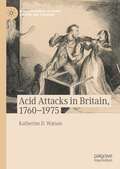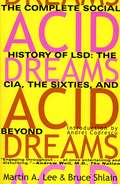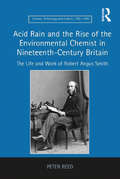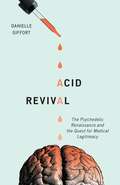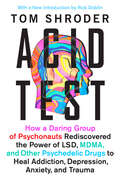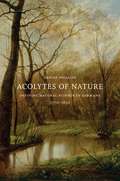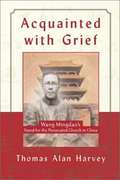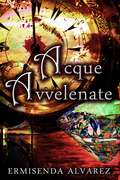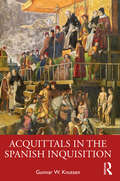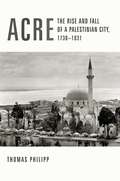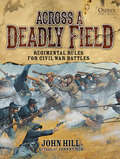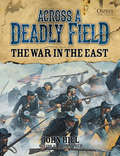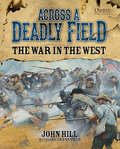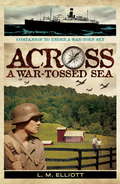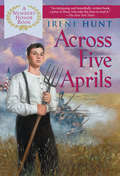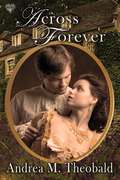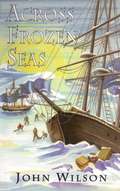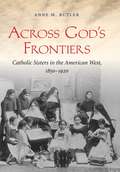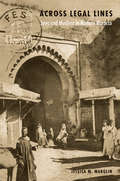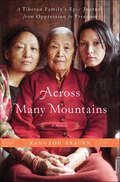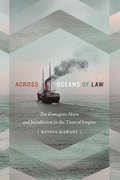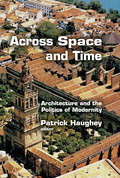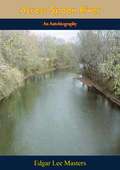- Table View
- List View
Acid Attacks in Britain, 1760–1975 (World Histories of Crime, Culture and Violence)
by Katherine D. WatsonThis Palgrave Pivot examines the history of the largely urban offence once known as vitriol throwing because the substance most commonly used was strong sulphuric acid, oil of vitriol. A relatively rare form of assault, it was motivated largely by revenge or jealousy and, because it was specifically designed to blind and mutilate, commonly targeted the victim’s face. The incidence of what was thus widely acknowledged to be an exceptionally cruel crime plateaued in the period 1850–1930 amid a sometimes surprisingly lenient legal response, before declining as a result of post-war social changes. In examining the factors that influenced both the crime and its punishment, the book makes an important contribution to criminal justice history by illuminating the role of gender, law and emotion from the perspective of both victim and perpetrator.
Acid Dreams: The CIA, the Sixties, and Beyond
by Martin A. Lee Bruce ShlainMartin Lee and Bruce Shlain's exhaustively researched and astonishing account -- part of it gleaned from secret government files -- tells how the CIA became obsessed with LSD as an espionage weapon during the early l950s and launched a massive covert research program, in which countless unwitting citizens were used as guinea pigs. Though the CIA was intent on keeping the drug to itself, it ultimately couldn't prevent it from spreading into the popular culture; here LSD had a profound impact and helped spawn a political and social upheaval that changed the face of America.
Acid Rain and the Rise of the Environmental Chemist in Nineteenth-Century Britain: The Life and Work of Robert Angus Smith (Science, Technology and Culture, 1700-1945)
by Peter ReedRobert Angus Smith (1817-1884) was a Scottish chemist and a leading investigator into what came to be known as 'acid rain'. This study of his working life, contextualized through discussion of his childhood, education, beliefs, family, interests and influences sheds light on the evolving understanding of sanitary science during the nineteenth century. Born in Glasgow and initially trained for a career in the Church of Scotland, Smith instead went on to study chemistry in Germany under Justus von Liebig. On his return to Manchester in the 1840s, Smith's strong Calvinist faith lead him to develop a strong concern for the insanitary environmental conditions in Manchester and other industrial towns in Britain. His appointment as Inspector of the Alkali Administration in 1863 enabled him to marry his social concerns and his work as an analytical chemist, and this book explores his role as Inspector of the Administration from its inception through battles with chemical manufacturers in the courts, to the struggle to widen and tighten the regulatory framework as other harmful chemical nuisances became known. This study of Smith’s life and work provides an important background to the way that 'chemical' came to have such negative connotations in the century before publication of Rachel Carson's Silent Spring. It also offers a fascinating insight into the changing landscape of British politics as regulation and enforcement of the chemical industries came to be seen as necessary, and is essential reading for historians of science, technology and industry in the nineteenth century, as well as environmental historians seeking background context to the twentieth-century environmental movements.
Acid Revival: The Psychedelic Renaissance and the Quest for Medical Legitimacy
by Danielle GiffortA vivid analysis of the history and revival of clinical psychedelic science Psychedelic drugs are making a comeback. In the mid-twentieth century, scientists actively studied the potential of drugs like LSD and psilocybin for treating mental health problems. After a decades-long hiatus, researchers are once again testing how effective these drugs are in relieving symptoms for a wide variety of psychiatric conditions, from depression and obsessive–compulsive disorder to posttraumatic stress disorder and substance addiction. In Acid Revival, Danielle Giffort examines how this new generation of researchers and their allies are working to rehabilitate psychedelic drugs and to usher in a new era of psychedelic medicine. As this team of researchers and mental health professionals revive the field of psychedelic science, they are haunted by the past and by one person in particular: psychedelic evangelist Timothy Leary. Drawing on extensive archival research and interviews with people working on scientific psychedelia, Giffort shows how today&’s researchers tell stories about Leary as an &“impure&” scientist and perform his antithesis to address a series of lingering dilemmas that threaten to rupture their budding legitimacy. Acid Revival presents new information about the so-called psychedelic renaissance and highlights the cultural work involved with the reassembly of dormant areas of medical science. This colorful and accessible history of the rise, fall, and reemergence of psychedelic medicine is infused with intriguing narratives and personalities—a story for popular science aficionados as well as for scholars of the history of science and medicine.
Acid Test: How a Daring Group of Psychonauts Rediscovered the Power of LSD, MDMA, and Other Psychedelic Drugs to Heal Addiction, Depression, Anxiety, and Trauma
by Tom ShroderIt's no secret that psychedelic drugs have the ability to cast light on the miraculous reality hidden within our psyche. Almost immediately after the discovery of LSD less than a hundred years ago, psychedelics began to play a crucial role in the quest to understand the link between mind and matter. With an uncanny ability to reveal the mind's remote frontiers and the unmapped areas of human consciousness, LSD and MDMA (better known as Ecstasy) have proven extraordinarily effective in treating anxiety disorders such as PTSD--yet the drugs remain illegal for millions of people who might benefit from them. Anchoring Tom Shroder's Acid Test are the stories of Rick Doblin, the founder and executive director of the Multidisciplinary Association for Psychedelic Studies (MAPS), who has been fighting government prohibition of psychedelics for more than thirty years; Michael Mithoefer, a former emergency room physician, now a psychiatrist at the forefront of psychedelic therapy research; and his patient Nicholas Blackston, a former Marine who has suffered unfathomable mental anguish from the effects of brutal combat experiences in Iraq. All three men are passionate, relatable people; each flawed, each resilient, and each eccentric, yet very familiar and very human. Acid Test covers the first heady years of experimentation in the fifties and sixties, through the backlash of the seventies and eighties, when the drug subculture exploded and uncontrolled use of street psychedelics led to a PR nightmare that created the drug stereotypes of the present day. Meticulously researched and astoundingly informative, this is at once a personal story of intertwining lives against an epic backdrop, and a compelling argument for the unprecedented healing properties of drugs that have for decades been characterized as dangerous, illicit substances.
Acolytes of Nature: Defining Natural Science in Germany, 1770-1850
by Denise PhillipsAlthough many of the practical and intellectual traditions that make up modern science date back centuries, the category of “science” itself is a relative novelty. In the early eighteenth century, the modern German word that would later mean “science,” naturwissenschaft, was not even included in dictionaries. By 1850, however, the term was in use everywhere. Acolytes of Nature follows the emergence of this important new category within German-speaking Europe, tracing its rise from an insignificant eighteenth-century neologism to a defining rallying cry of modern German culture. Today’s notion of a unified natural science has been deemed an invention of the mid-nineteenth century. Yet what Denise Phillips reveals here is that the idea of naturwissenschaft acquired a prominent place in German public life several decades earlier. Phillips uncovers the evolving outlines of the category of natural science and examines why Germans of varied social station and intellectual commitments came to find this label useful. An expanding education system, an increasingly vibrant consumer culture and urban social life, the early stages of industrialization, and the emergence of a liberal political movement all fundamentally altered the world in which educated Germans lived, and also reshaped the way they classified knowledge.
Acolytes of Nature: Defining Natural Science in Germany, 1770–1850
by Denise PhillipsAlthough many of the practical and intellectual traditions that make up modern science date back centuries, the category of “science” itself is a relative novelty. In the early eighteenth century, the modern German word that would later mean “science,” naturwissenschaft, was not even included in dictionaries. By 1850, however, the term was in use everywhere. Acolytes of Nature follows the emergence of this important new category within German-speaking Europe, tracing its rise from an insignificant eighteenth-century neologism to a defining rallying cry of modern German culture. Today’s notion of a unified natural science has been deemed an invention of the mid-nineteenth century. Yet what Denise Phillips reveals here is that the idea of naturwissenschaft acquired a prominent place in German public life several decades earlier. Phillips uncovers the evolving outlines of the category of natural science and examines why Germans of varied social station and intellectual commitments came to find this label useful. An expanding education system, an increasingly vibrant consumer culture and urban social life, the early stages of industrialization, and the emergence of a liberal political movement all fundamentally altered the world in which educated Germans lived, and also reshaped the way they classified knowledge.
Acquainted With Grief: Wang Mingdao's Stand for the Persecuted Church in China
by Thomas Alan HarveyStory of Wang Mingdao and the House Church in China.
Acque Avvelenate
by Ermisenda Alvarez Elisa PardiniErrori pagati col sangue, brutte cicatrici e splendide bugie. Una storia di corruzione. Helen Gardener viene assassinata durante una crociera su un transatlantico. La Diamond Royale parte da Southampton con a bordo il suo assassino. Ambientato negli anni '50, Acque Avvelenate narra le storie di sette sfortunati personaggi in qualche modo colpiti dalla sua morte. Si è trattato solo di un incidente? Il signor Phillips, proprietario della nave e ospite della crociera, governa con il pugno di ferro, alla ricerca di qualcosa... o di qualcuno. Le bugie prendono il sopravvento mentre i sospettati cercano di sopravvivere agli ultimi giorni sulla nave. Vivendo il conflitto tra la propria morale, la cupidigia e la lussuria, capiscono chi sno realmente. Chi arriverà in alto? Chi cadrà? Chi ha ucciso Helen Gardener?
Acquired Alterity: Migration, Identity, and Literary Nationalism (New Interventions in Japanese Studies #3)
by Edward MackA free open access ebook is available upon publication. Learn more at www.luminosoa.org. This is the first book-length study in English of the Japanese-language literary activities of early Japanese migrants to Brazil. It provides a detailed history of Japanese-language bookstores, serialized newspaper fiction, original creative works, and critical apparatuses that existed in Brazil prior to World War II. This case study of the reading and writing of one diasporic population challenges the dominant mode of literary study, in which texts are often explicitly or implicitly understood through a framework of ethno-nationalism. Self-representations by writers in the diaspora reveal flaws in this prevailing framework through what Edward Mack calls "acquired alterity," in which expectations about the stability of ethnic identity are subverted in surprising ways. Acquired Alterity encourages a reconsideration of the ramifications (and motivations) of cultural analyses of texts and the constructions of peoplehood that are often the true objects of literary knowledge production.
Acquittals in the Spanish Inquisition
by Gunnar W. KnutsenThe Spanish Inquisition has become such a byword for injustice that many forget it was also a judicial system capable of acquittal. This study of more than 67,000 trials uncovers over 2,500 formal acquittals, more than 6,600 suspended trials, and nearly 2,100 with unknown or no recorded outcomes.The inquisitors were jurists who frequently held other judgeships before and after their tenure and used the same evidentiary rules as other Spanish courts. If every acquittal may be taken as an admission of error, the Spanish Inquisition admitted its errors thousands of times, occasionally even putting them on public display at the autos de fe. An acquittal can also be taken as a sign that the inquisitors did not wish to punish the innocent and that while they were quick to arrest and charge people on flimsy evidence, they were too conscientious to convict them without further proof. However, it is also clear that the Holy Office at times did bend, twist, or even break the law when it suited it in order to secure a conviction.This book is aimed at students, scholars, and general readers seeking a nuanced understanding of the Spanish Inquisition and its workings.
Acre: The Rise and Fall of a Palestinian City, 1730-1831 (History and Society of the Modern Middle East)
by Thomas PhilippThomas Philipp's study of Acre combines the most extensive use to date of local Arabic sources with commercial records in Europe to shed light on a region and power center many identify as the beginning of modern Palestinian history. The third largest city in eighteenth-century Syria—after Aleppo and Damascus—Acre was the capital of a politically and economically unique region on the Mediterranean coast that included what is today northern Israel and southern Lebanon. In the eighteenth century, Acre grew dramatically from a small fishing village to a fortified city of some 25,000 inhabitants. Cash crops (first cotton, then grain) made Acre the center of trade and political power and linked it inextricably to the world economy. Acre was markedly different from other cities in the region: its urban society consisted almost exclusively of immigrants seeking their fortune. The rise and fall of Acre in the eighteenth and nineteenth centuries, Thomas Philipp argues, must be seen against the background of the decay of central power in the Ottoman empire. Destabilization of imperial authority allowed for the resurfacing of long-submerged traditional power centers and the integration of Arab regions into European and world economies. This larger imperial context proves the key to addressing many questions about the local history of Acre and its peripheries. How were the new sources of wealth and patterns of commerce that remade Acre reconciled with traditional forms of political power and social organization? Were these forms really traditional? Or did entirely new classes develop under the circumstances of an immigrant society and new commercial needs? And why did Acre, after such propitious beginnings as a center of export trade and political and military power strong enough to defy Napoleon, give way to the dazzling rise of Beirut in the nineteenth century? For centuries the object of the Crusader's fury and the trader's envy, Acre is here restored to its full significance at a crucial moment in Middle Eastern history.
Across A Deadly Field - Regimental Rules for Civil War Battles
by John HillManassas, Shiloh, Gettysburg, Atlanta, and Petersburg are just a few of the many large scale Civil War battles that gamers enjoy simulating on the tabletop. Up until now, CW (Civil War) games have either taken a regimental approach for a more tactical game or a brigade-level view for a more grand tactical game - and gamers have plenty of both regimental or brigade level CW rule sets to choose from. However, both approaches have drawbacks. The pure regimental approach - such as in Johnny Reb - can make it difficult to fight a very large battle, while the brigade approach often fails to capture the unique feel of the CW where the actions of one regiment - such as the 20th Maine at Little Round Top - could turn a battle. Across A Deadly Field offers a game system that enables gamers to fight large battles in a relatively compact space, yet maintains the regimental focus and flavor appropriate to the conflict. Across A Deadly Field uses a scale that can be described as a "telescoped" version of Johnny Reb III - with twice the ground and figure scale, and has individual regiments and batteries as the base element of maneuver:- Ground Scale: 1" = 100 yards- Time Scale: 1 turn = 20 minutes- Regiment Scale: Two stands/bases per regiment- Figure Scale: 1 figure = 60 men- Gun scale: 1 gun = 1 batteryThe big advantage of this approach is that the gamer is not required to rebase any figures from his existing Johnny Reb army, allowing for much easier conversion from the older game to Across A Deadly Field. The existing four-stand regiments become two different regiments of two stands each - his miniature army has, for gaming purposes, just doubled. This will hold an appeal for many gamers - they can either recreate smaller engagements in half the space that would once have been needed, or can game huge battles on a table that would once have only accommodated a small skirmish. In essence, Across A Deadly Field offers two games with a single, consistent basing system.
Across A Deadly Field - The War in the East
by Mark Stacey John HillThis supplement for Across A Deadly Field includes a number of scenarios of differing size and complexity, intended to give players a wide variety of options for their American Civil War games. The scenarios cover a number of the most famous battles of the Eastern Theater, including 1st Bull Run, Antietam, Chancellorsville, Brandy Station and Gettysburg, and offer both modestly sized and larger battles to the player. The smaller scenarios focus not only on smaller battles, but also on engagements within a larger encounter, while the larger scenarios present a wider view of a battle. For example, Antietam offers the three distinct corps-level actions in the north, center and the south at Burnside's Bridge, as well as the full battle. This offers Across A Deadly Field players a versatility that can accommodate their preferences and collections without sacrificing either playability of historical accuracy.
Across A Deadly Field - The War in the West
by Mark Stacey John HillThe War in the West, the new supplement for Across A Deadly Field brings to the tabletop the bitter struggles of the Western Theatre of the American Civil War. The special rules and scenarios included in this volume give players everything they need to recreate the battles, both great and small, of this theatre of the war. Battles such as Shiloh, Stone River, Vicksburg, Chickamauga, Chattanooga and Atlanta are presented in great detail, offering players of Across a Deadly Field not only a range of scenario options, but the ability to play through a full campaign.
Across A War-Tossed Sea
by L.M. ElliottIt's 1943, and World War II is raging. To escape the terror of the Blitz, ten-year-old Wesley and fourteen-year-old Charles were evacuated from England to America. After a few near misses with German U-boats and a treacherous ocean crossing, the brothers arrived in Virginia. The culture shock is intense as the London boys adjust to rural farm life and have to learn new sports, customs, and spellings, plus contend with racial segregation and bullying. As time goes by, the brothers begin to adapt to their new reality and blaze their own trails, writing letters home, making new friends, and pitching in to the American war effort. But just when Wes and Charles think they are safe from the terror of the battles raging thousands of miles across the sea, they encounter the very brand of soldiers they were trying to escape: Nazis, from a POW camp right around the corner and U-boats torpedoing American ships off the nearby Atlantic coastline. Suddenly, Charles, Wesley, and their new Virginian family must face the dangers of a foreign war coming too close to home. Award-winning author L. M. Elliott brings a rarely told story of World War II on U.S. soil to light in this gripping and meticulously-researched novel, a companion to the beloved Under a War-Torn Sky.
Across Five Aprils
by Irene HuntThe unforgettable story of young Jethro Creighton who comes of age during the turbulent years of the Civil War.<P><P> Newbery Award Honors book
Across Forever
by Andrea M. TheobaldReeling from secretly observing her boyfriend cheating with a female colleague, as a distraction from the anguish she experiences, Ashley Jones visits an exhibit about American heiresses who’d married English lords. To her amazement, the curator shows her a painted subject, Lady Harriet Davenport, who could have been her 19th-century doppelganger. She studies the woman’s beautiful, hauntingly sad face and reads up on her equally sad history—of being separated from her true love in America only to end up in a loveless marriage or, rather, a marriage of convenience faraway in England. Ashley returns to her small apartment and feels a strange connection with the woman who’d apparently died sleepwalking in a blizzard while her husband was away with his mistress. When she falls asleep on her sofa, she awakens in a four-poster bed in the presence of a chambermaid. Somehow, she has traversed the boundaries of time to enter Lady Harriet Davenport’s body. She experiences the stroppy family, discovers a hidden diary chronicling the woman’s adulteress lifestyle, and the paranoid belief someone is out to kill her. The aloof Lord Richard Davenport is a man determined to have everything his way. When he meets the new version of his wife—an incredibly stubborn, feisty natured, argumentative, and ill-behaved woman—he tries to improve her, only for Ashley to openly resist, deliberately creating upheaval in his boring, structured life. Entries in Harriet’s diary note he only married her for the money and that he had a mistress who often came to stay with him at Evercrest Hall. Ashley doesn’t count on falling in love with Lord Davenport, and she senses his feelings are growing for her despite what Harriet had said about his cold, unkind nature toward her in the diary. The problem is the rapidly growing bond between them triggers a chain of events detrimental to her existence as she experiences firsthand strange occurrences in the night and threats to her, Lord Davenport, and his young family’s lives.
Across Frozen Seas
by John WilsonShort-listed for the 1998 Sheila A. Egoff Award for Children’s Literature and Geoffrey Bilson Award In his third young adult title, John Wilson takes on the rich territory of the 1845 Franklin expedition. Cabin boy David Young travels aboard the ill-fated vessel the HMS Erebus from London, England, en route to Canada’s frozen and uncharted north, and his adventures comes to a modern-day Dave Young in Humboldt, Saskatchewan, in a series of dreams.
Across God's Frontiers
by Anne M. ButlerRoman Catholic sisters first traveled to the American West as providers of social services, education, and medical assistance. In Across God's Frontiers, Anne M. Butler traces the ways in which sisters challenged and reconfigured contemporary ideas about women, work, religion, and the West; moreover, she demonstrates how religious life became a vehicle for increasing women's agency and power. Moving to the West introduced significant changes for these women, including public employment and thoroughly unconventional monastic lives. As nuns and sisters adjusted to new circumstances and immersed themselves in rugged environments, Butler argues, the West shaped them; and through their labors and charities, the sisters in turn shaped the West. These female religious pioneers built institutions, brokered relationships between Indigenous peoples and encroaching settlers, and undertook varied occupations, often without organized funding or direct support from the church hierarchy. A comprehensive history of Roman Catholic nuns and sisters in the American West, Across God's Frontiers reveals Catholic sisters as dynamic and creative architects of civic and religious institutions in western communities.
Across Legal Lines: Jews and Muslims in Modern Morocco
by Jessica M. MarglinA previously untold story of Jewish-Muslim relations in modern Morocco, showing how law facilitated Jews' integration into the broader Moroccan society in which they lived Morocco went through immense upheaval in the nineteenth and early twentieth centuries. Through the experiences of a single Jewish family, Jessica Marglin charts how the law helped Jews to integrate into Muslim society--until colonial reforms abruptly curtailed their legal mobility. Drawing on a broad range of archival documents, Marglin expands our understanding of contemporary relations between Jews and Muslims and changes the way we think about Jewish history, the Middle East, and the nature of legal pluralism.
Across Many Mountains: A Tibetan Family's Epic Journey from Oppression to Freedom
by Yangzom BrauenA powerful, emotional memoir and an extraordinary portrait of three generations of Tibetan women whose lives are forever changed when Chairman Mao's Red Army crushes Tibetan independence, sending a young mother and her six-year-old daughter on a treacherous journey across the snowy Himalayas toward freedomKunsang thought she would never leave Tibet. One of the country's youngest Buddhist nuns, she grew up in a remote mountain village where, as a teenager, she entered the local nunnery. Though simple, Kunsang's life gave her all she needed: a oneness with nature and a sense of the spiritual in all things. She married a monk, had two children, and lived in peace and prayer. But not for long. There was a saying in Tibet: "When the iron bird flies and horses run on wheels, the Tibetan people will be scattered like ants across the face of the earth." The Chinese invasion of Tibet in 1950 changed everything. When soldiers arrived at her mountain monastery, destroying everything in their path, Kunsang and her family fled across the Himalayas only to spend years in Indian refugee camps. She lost both her husband and her youngest child on that journey, but the future held an extraordinary turn of events that would forever change her life--the arrival in the refugee camps of a cultured young Swiss man long fascinated with Tibet. Martin Brauen will fall instantly in love with Kunsang's young daughter, Sonam, eventually winning her heart and hand, and taking mother and daughter with him to Switzerland, where Yangzom will be born. Many stories lie hidden until the right person arrives to tell them. In rescuing the story of her now 90-year-old inspirational grandmother and her mother, Yangzom Brauen has given us a book full of love, courage, and triumph,as well as allowing us a rare and vivid glimpse of life in rural Tibet before the arrival of the Chinese. Most importantly, though, ACROSS MANY MOUNTAINS is a testament to three strong, determined women who are linked by an unbreakable family bond.
Across Oceans of Law: The Komagata Maru and Jurisdiction in the Time of Empire (Global and Insurgent Legalities)
by Renisa MawaniIn 1914 the British-built and Japanese-owned steamship Komagata Maru left Hong Kong for Vancouver carrying 376 Punjabi migrants. Chartered by railway contractor and purported rubber planter Gurdit Singh, the ship and its passengers were denied entry into Canada and two months later were deported to Calcutta. In Across Oceans of Law Renisa Mawani retells this well-known story of the Komagata Maru. Drawing on "oceans as method"—a mode of thinking and writing that repositions land and sea—Mawani examines the historical and conceptual stakes of situating histories of Indian migration within maritime worlds. Through close readings of the ship, the manifest, the trial, and the anticolonial writings of Singh and others, Mawani argues that the Komagata Maru's landing raised urgent questions regarding the jurisdictional tensions between the common law and admiralty law, and, ultimately, the legal status of the sea. By following the movements of a single ship and bringing oceans into sharper view, Mawani traces British imperial power through racial, temporal, and legal contests and offers a novel method of writing colonial legal history.
Across Space and Time: Architecture and the Politics of Modernity
by Patrick HaugheyModernity tends to be considered a mostly Western, chronologically recent concept. Looking at locations in Brazil, Java, India, Georgia, and Yugoslavia, among others, Across Space and Time provides architectural and cultural evidence that modernity has had an impact across the globe and for much longer than previously conceived. This volume moves through space and time to illustrate the way global modernity has been negotiated through architecture, urban planning, design pedagogies, preservation, and art history in diverse locations around the world. Bringing together emerging and established architecture and art history scholars, each chapter focuses on a particular site where modernity was defined, challenged, or reinterpreted. The contributors examine how architectures, landscapes, and design thinking influence and are influenced by conflicts between cultural, economic, technological, and political forces. By invoking well-researched histories to ground their work in a post-colonial critique, they closely examine many prevailing myths of modernity. Notable topics include emerging architectural history in the Indian subcontinent and the connection between climate change and architecture. Ultimately, Across Space and Time contributes to the ongoing critique of architecture and its history, both as a discipline and within the academy. The authors insist that architecture is more than a style. It is a powerful expression of representational power that reveals how a society negotiates its progress.
Across Spoon River: An Autobiography (American Biography Ser.)
by Edgar Lee MastersThe memoirs of one of Illinois’ great poets, author of Spoon River Anthology, with many vignettes of the Chicago Renaissance.This intimate and provocative autobiography, first published in 1936, reveals the innermost thoughts of a great American poet. Edgar Lee Masters was a transitional figure in American literature with one foot planted in the nineteenth century and the other firmly placed on the path of what we now think of as the modern period.Richly illustrated throughout with black and white photographs.“Across Spoon River: An Autobiography is blunt and cranky about a life [Masters] saw as largely “scrappy and unmanageable.” Emphasizing life on his grandfather’s farm, his school days, his political battles, the workday world, and the growth of a poet’s mind through wide reading, the book is a valuable record of Masters’s work habits and offers considerable insight on his position as a critic and his place in American literature.”—Ronald Primeau, American National Biography
